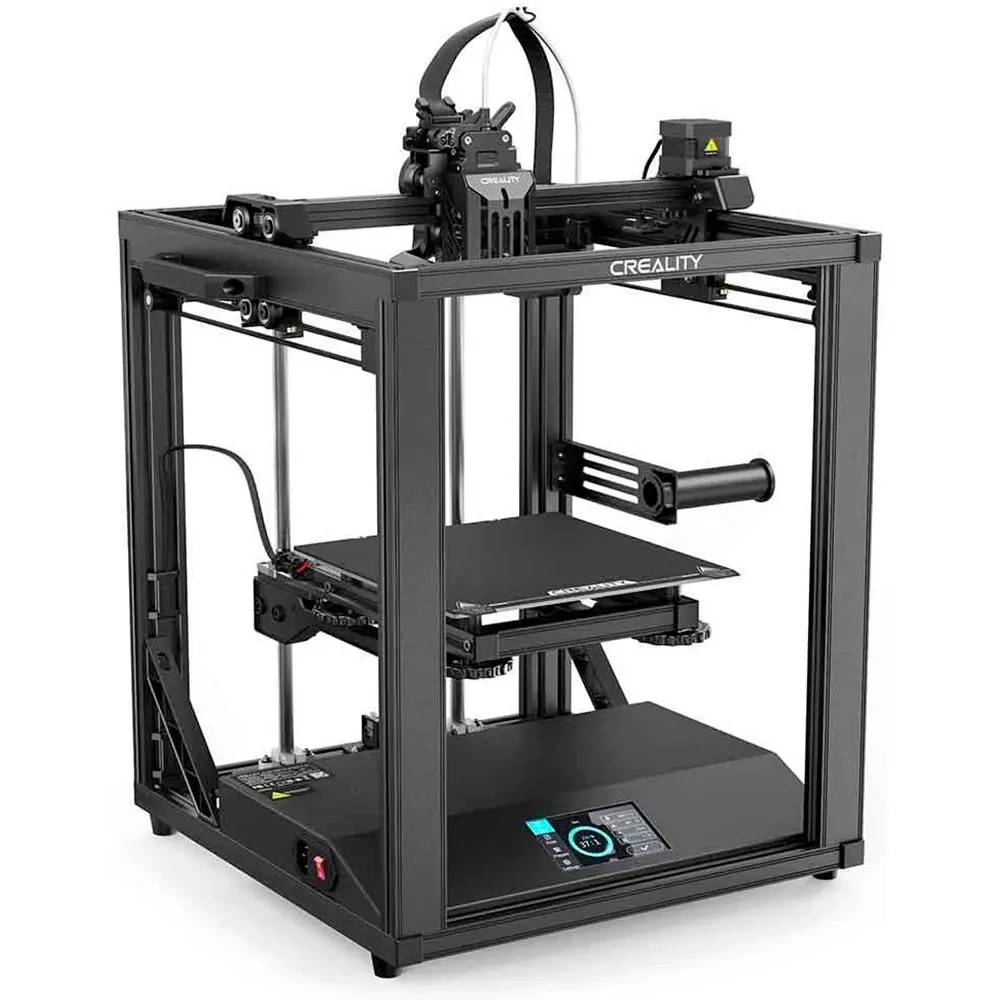Compare CR 10 Smart Pro vs Ender 5 S1
Comparison between the best 3D printers
Choose the best 3D printer at the best price. The cheapest 3D printers are here.
Buy a 3D printer here with 3D Fila.
 |
 |
|
| Model | CR 10 Smart Pro[BUY CR 10 Smart Pro] |
Ender 5 S1 |
| Printing Material | Filament | Filament |
| Buy Filament for Creality 3D CR 10 Smart Pro | Buy Filament forCreality 3D Ender 5 S1 | |
| Estimated price | $900,00 | $467,00 |
| Manufacturer | Creality 3D | Creality 3D |
| Release Year | 2020 | 2022 |
| Print Volume [mm] | 300x300x400 | 220x220x280 |
| Printer Size [mm] | 578x522x648 | 425x460x570 |
| Weight [kg] | 13,6 | 12,1 |
| Power Loss Recovery | YES | YES |
| Enclosed printer | NO | NO |
| Bed Leveling | Manual | Automatic |
| Filament End Sensor | YES | YES |
| Bed type | Heated | Heated |
| Power supply system | Bowden | Direct Drive |
| Standard nozzle | 0,4 | 0,4 |
| Maximum Nozzle Temperature [°C] | 300 | 300 |
| Maximum Bed Temperature [°C] | 100 | 110 |
| Maximum printing speed [mm/s] | 50 | 250 |
| Filament holder | YES | YES |
| Camera for supervision | YES | YES |
| Recommended filaments | PLA, PETG, Tritan, Flex, ABS | PLA, ABS, PETG, TPU, PC, ASA, HIPS |
| Recommended slicers | Cura, Simplify, Slic3r, IdeaMaker | Cura, Simplify, Slic3r, IdeaMaker |
| Maximum Resolution [mm] | 0,1 | 0,05 |
| Processor | 32 Bits | |
| Display | Display touchscreen 4,3'' | Display touchscreen 4,3 '' |
| Power Supply | 110/220V / 350W | 350 W |
| Connectivity | SD / USB / Wi-Fi / Ethernet | SD / USB / Wi-Fi |
| Operating systems | Windows, Mac, Linux | Windows, Mac, Linux |
| Date of registration in the system | 2022-11-04 | 2023-10-04 |
| Release date | 2020 | 2022 |
| Extra features | Creality's CR-10 Smart Pro printer offers a large 300x300x400mm build volume, Sprite Pro direct extruder for multiple materials, CR Touch auto-leveling, PEI magnetic bed, 4.3" touchscreen, LED lighting, and Creality Cloud connectivity. Some areas of improvement include the use of brass spindle nuts and tinned wires. | A steel drive shaft synchronizes the two Y-axis belts. High-torque 42-48 Y-axis motor for responsive and precise movement. Cartesian structure. Enhanced stability by thick linear shafts, extra stiffeners, two cantilevers, and silicone bumpers. Double Die Spring profile reinforcement. Silicone bed support. All-metal Sprite direct extruder. Best for printing with flexible filaments like TPU. Auto-calibration with 16-point CR Touch. Compatible with Sonic Pad, Wifi Box, and Camera kit. |
| Support for multiple colors and materials (AMS and CFS) | NO | NO |
Notes * |
||
| Cost-benefit | 6 / 10 | 7 / 10 |
| Hardware | 2.5 / 10 | 2.4 / 10 |
| Tela | . | . |
| Print volume | 4 / 10 | 3 / 10 |
| Performance | 1 / 10 | 2 / 10 |
| [BUY CR 10 Smart Pro] |
Conclusion |
| In comparing the CR-10 Smart Pro and the Ender 5 S1, both 3D printers present unique strengths and weaknesses relevant to different user needs. The CR-10 Smart Pro, with its larger print volume and a variety of advanced features such as the Sprite Pro direct extruder and CR Touch auto-leveling, stands out as a robust option for users seeking versatility in materials and ease of use. Its greater print capacity can allow for larger projects, making it an appealing choice for those who need to produce larger parts or complex models. However, it comes at a higher price point, which may not fit every budget. On the other hand, the Ender 5 S1 offers an excellent cost-benefit ratio, making it a strong contender for hobbyists or users who require a reliable machine without breaking the bank. While its print volume is smaller, it compensates with impressive print speed and more advanced print quality due to its auto-calibration capabilities. Additionally, it supports a wider range of filaments, which can enhance its versatility for different printing tasks. In conclusion, if budget is a primary consideration and the user values performance, specifically related to speed and material flexibility, the Ender 5 S1 is the better choice. However, for users who prioritize larger print volumes and are willing to invest more for advanced features and enhanced usability, the CR-10 Smart Pro would be the preferred option. Ultimately, the decision should align with the user’s specific printing needs, preferences, and budget constraints. |

